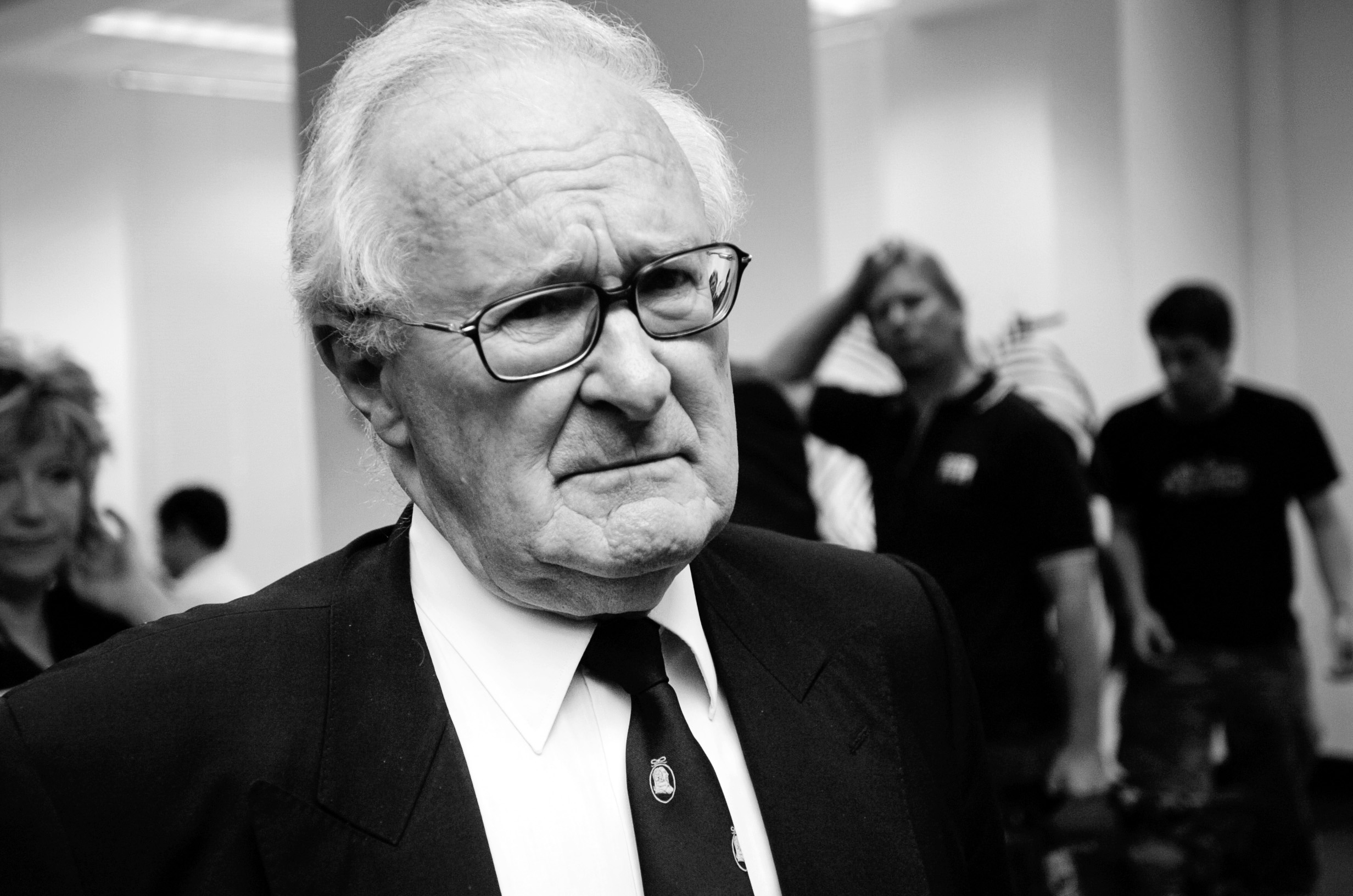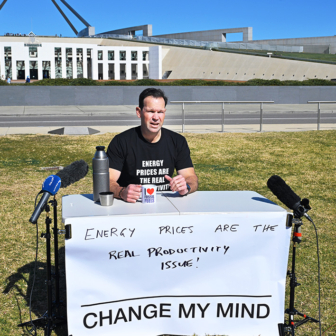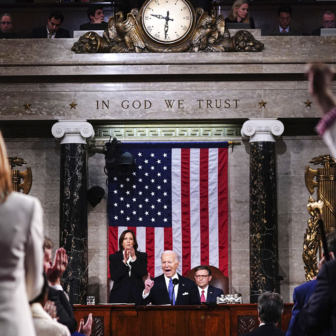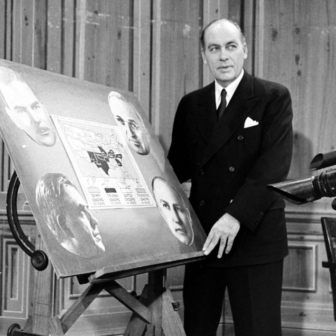The obituaries for former Treasury secretary and National Party senator John Stone — who died last week at the age of ninety-six — have so far focused on his thirty-year career as a public servant, with his even longer second act as a political activist treated as something of a footnote. This is misleading. Stone’s arch-reactionary politics were central to his every contribution to public life. Along with Western Mining executives Hugh Morgan and Ray Evans, Stone was at the heart of the right-wing revival that began in the 1980s and whose influence remains with us today.
Stone’s unflagging commitment to a cause (and to winning an argument) is perhaps best illustrated by a famous tale that became part of Canberra folklore. While he was working as a Treasury official in the 1950s, Stone would have Friday night drinks with colleagues, academics and journalists. On one occasion Stone became involved in a bet with two other men over which of them could win a running race to Lake George, twenty-six miles away. They decided to settle the bet right away, and after ducking home to change into his running gear, Stone set off towards his destination. He reached Lake George in first place around 5am, another argument won.
Born in the Western Australian wheatbelt in 1929, Stone was a high achiever from an early age. In 1941 he won a scholarship to attend Perth Modern School, where he excelled in academic and sporting pursuits. He was a member of the WA Colts under-twenty-one representative hockey teams that were national champions in 1948 and 1949. He enrolled at the University of Western Australia and graduated with a Bachelor of Science, with first-class honours in mathematical physics, in 1950. Awarded a Rhodes scholarship to undertake an arts degree at Oxford University, he graduated with first-class honours in philosophy, politics and economics in 1954.
The parallels here with Stone’s later political opponent, Bob Hawke, are uncanny. Hawke was also born in 1929, attended Perth Modern School and UWA, and won a Rhodes scholarship to study philosophy, politics and economics at Oxford. Both also served as president of the undergraduate guild at UWA. But there was never any love lost between the two.
“I’d have to say Bob was rather unrecognised in the intellectual stakes,” recalled Stone in 1987. “I didn’t know him very well, I didn’t think he was a very nice boy. He wasn’t my type. He was a bit of a lair, loudmouthed, cocky and full of himself even then.” Hawke returned fire with his own recollections of their youthful rivalry in his 1994 memoirs. “Stone, whom I inherited decades later as Secretary of Treasury,” he wrote, “exhibited at that early stage all the arrogance and cynical contempt for his fellows which were to characterise his distinguished career as a public servant.”
Returning to Australia from Oxford, Stone took up a position in the federal Treasury, where he remained for the next thirty years, except for the period 1967–70, when he worked at the International Monetary Fund and World Bank in Washington. He became a deputy Treasury secretary in 1971 before being appointed to the top job in 1979. He soon made his hardline position on industrial relations clear when Malcolm Fraser asked him to prepare a memorandum of advice for an incoming conservative government in Britain. “Union power has become a threat not merely to economic stability,” he wrote, “but to civil liberties and the very concept of the rule of law upon which the British society has been founded and of which it has been for so long such a notable exemplar.”
Stone had initially been encouraged by Fraser’s strong electoral mandate and apparent economic liberalism, but like many on the insurgent New Right he was left bitterly disappointed by the Fraser government. “How could Fraser leave office in 1983,” he recalled in 2007, “with so little achieved in turning back the Whitlamite tide of destruction that he had promised to reverse?” In March 1983 he voted Labor for only the second time in his life, and was kept on at Treasury by Paul Keating despite the reservations of Hawke’s cabinet. But Stone was always on borrowed time, and he resigned in August 1984 following increasing disagreement about the direction of economic policy.
Stone took a big risk in abandoning a long and successful public service career, but he revelled in the intellectual freedom his resignation enabled. He moved to Melbourne to become a senior fellow at the Institute of Public Affairs in 1985, and commenced writing regular articles on a wide variety of topics for the Sydney Morning Herald and Quadrant. Former High Court Justice Dyson Heydon summarised Stone’s outlook at this point as consisting of six propositions:
1. Governments had too much power in society.
2. The federal government had too much power in relation to other governments.
3. Within each government, a small core of ministers had too much power compared to other legislators.
4. Within each executive, the public service was becoming too politicised to give independent advice.
5. Trade unions had too much power over governments and other social forces.
6. These evils could only be exposed and combated by vigorous debate, which he saw as the lifeblood of democracy.
Shortly after resigning from Treasury, Stone delivered the Edward Shann Memorial Lecture in Economics at UWA. Titled “1929 and All That,” the lecture drew parallels between the state of the Australian economy in the 1980s and on the eve of the Great Depression, pointing to three key problems: “financial mismanagement, protectionism and ossified labour markets.”
Along with Gerard Henderson’s essay, “The Industrial Relations Club,” Stone’s speech provided the intellectual foundations for the formation of the anti-union advocacy group the H.R. Nicholls Society in 1986. Ray Evans described it as “arguably the seminal document in the campaign for liberalising the labour market.” Stone served as the H.R. Nicholls Society’s president for its first few years, and remained involved for decades. Though no longer influential, the organisation exists to this day.
It was in April 1987 that Stone accepted an offer to help develop Joh Bjelke-Petersen’s single-rate tax policy, which was to form a key part of the Queensland premier’s ill-fated “Joh for Canberra” campaign. Many were shocked to see such a respected figure as the former Treasury head associating with a man whom much of the country regarded as a joke. Stone responded in the only way he knew how: engaging in vigorous debate in defence of his position.
“In the end, it is policies — not political parties — that I care about,” he wrote. “I see in this initiative by the premier of Queensland… a real chance of turning around those policies which have brought Australia to its present pass. That is why I am working for Sir Joh.”
Before long, he had doubled down. Despite not being a member of the National Party, and never even having voted for it, Stone was offered the number two spot on the party’s Queensland Senate ticket (behind Sir Joh’s wife, Florence Bjelke-Petersen). Elected in July 1987, he immediately became the leader of the National Party in the Senate. Delivering his maiden speech in September, Stone wore his H.R. Nicholls Society tie, though he light-heartedly reassured other senators that “when I put on this tie this morning I had no intention of being provocative.”
Many — including Liberal leader John Howard — blamed the Joh for Canberra campaign for the Coalition’s 1987 election loss. Nevertheless, Stone served as Howard’s shadow minister for finance until Howard sacked him in September 1988. The sacking was ironic: Stone had supported Howard’s controversial remarks on the need to slow Asian immigration but then went further just as Howard was trying to calm things down.
“Howard,” wrote Paul Kelly, “having tolerated Stone’s transgressions on indirect taxation and immigration for fourteen months, felt compelled to act.” Stone was philosophical: “I bore Howard himself no ill will for this. As I said in a press conference the next day, he had probably done me a favour.” Though Stone would later be highly critical of Howard’s policies in government, he nevertheless concluded in 2009 that Howard was probably Australia’s greatest prime minister.
When Stone resigned from the Senate in March 1990 to contest the Queensland lower-house seat of Fairfax, many were perplexed. “It seems likely that John Stone will remain an unpredictable enigma,” wrote Gerard Henderson. “Few would doubt his ability or courage. But many will query his political judgement.” Stone’s unsuccessful attempt to switch chambers brought an end to his short career in electoral politics. After this setback he returned to his former role as a senior fellow at the IPA, and recommenced writing for Quadrant and various newspapers.
Stone’s next political project was inspired by what he perceived as a concerning and growing disregard for the federal principles of the Australian Constitution, especially by the Labor Party. Having already relied on a questionable interpretation of the Constitution’s external affairs power to prevent the Tasmanian government from constructing the Gordon-below-Franklin Dam, the Hawke government later tried to amend the Constitution with four simultaneous referendums in 1988. Though all four were soundly defeated, Stone remained alert to the prospect of further attempts.
In 1992, together with fellow constitutional conservatives, he established the Samuel Griffith Society to defend the Constitution “against all who would attempt to undermine it.” With assistance from his wife Nancy, he led the organisation until his retirement in 2009. Though its primary concern was the centralisation of power in Canberra, that issue was largely overwhelmed by two others that soon appeared on the agenda: the alarming prospect of an Australian republic, and the High Court’s Mabo decision recognising native title, which Stone described as “a fit of self-indulgent remorse, [which] overturned two centuries of settled Australian property law.”
Mabo in particular seemed to unleash something visceral in Stone. Having already been accused of racism against Asians in the 1980s (and later — following the 11 September terrorist attacks — against Muslims), Stone’s contempt for First Peoples and their culture became an ongoing feature of his writing. “The less said about the violence-racked, female-oppressive, sexually predatory cultures of the Australian Aboriginal the better,” he wrote in the Australian in 2010. Introducing a 2017 address to the Samuel Griffith Society, Stone declared, to laughter from the audience: “I’m beginning with a welcome to country — a welcome to our country. So let me begin by acknowledging the traditional owners of this land: King George III and his heirs and assigns.” His final piece of published writing, for the Australian edition of the Spectator in March 2023, was a passionate denunciation of the proposed Indigenous Voice to Parliament.
Perhaps this is what Dyson Heydon had in mind when he described Stone as “peppery and pugnacious.” Heydon recalled that “many a speaker at a Quadrant dinner or a Samuel Griffith Society conference or an H.R. Nicholls Society meeting will take to their graves the vivid recollection of the puzzled and frowning face of John, advancing towards the podium in order to extirpate the speaker’s fallacies with the intellectual equivalent of fire and sword.”
On the other hand, as one journalist found after interviewing him in 1987, he could be a model of civility: “There is a polite, old-fashioned charm about Stone: he calls everyone ‘Mr,’ he observes all the correct rituals, his cultural style is donnish, patronising, somewhat upper class.” In my own email correspondence with him he was unfailingly courteous and generous with his reminiscences. But none of this excuses the racism and white supremacy that seemed embedded in his political worldview.
Advancing age did nothing to dull Stone’s passion for political debate. In March 2016, conservative columnist Miranda Devine coined the term “del-con” to describe those “delusional conservatives” — including Stone — who remained firmly in Tony Abbott’s camp following Malcolm Turnbull’s successful coup. Though Stone preferred the term “dis-con” — disaffected, rather than delusional — he embraced the criticism. It prompted a regular “dis-con notes” column in the Spectator, where he attacked Turnbull ferociously, mocked the Liberal “bed-wetters” who installed him, and gave forthright advice to Liberal MPs about standing up for conservative values. He urged a restoration of Abbott or, failing that, a new leader with comparable right-wing bona fides, such as Peter Dutton.
Stone was never convinced by Scott Morrison, so the Coalition’s defeat in 2022 came as something of a relief. Counselling readers against despair at the prospect of a Labor government, he immediately foresaw green shoots of recovery under Dutton: “The bottom line is this: from their election wreckage, the good Lord has so arranged matters that, under Dutton’s leadership (and predictably, with a lot of help from Albanese), the Liberals now have the capacity to recover their lost conservative ground. So dry your tears, snowflakes. All is not lost; on the contrary, the Liberals’ recovery should now begin.”
What a devastating blow, then, Dutton’s catastrophic 2025 election defeat must have been for this grand old man of the Australian right. Perhaps Devine was correct to call him delusional, after all. •




